Addison Mizner
| Addison Mizner | |
|---|---|
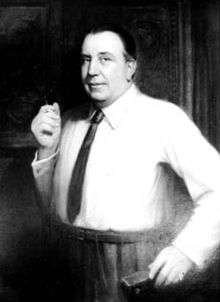 | |
| Born |
December 12, 1872 Benicia, California |
| Died |
February 5, 1933 (aged 60) Palm Beach, Florida |
| Occupation | Architect |
| Buildings |
Everglades Club El Mirasol (demolished) Riverside Baptist Church Boca Raton Resort & Club La Guerida (U. S. President John F. Kennedy's "Winter White House") |
Addison Cairns Mizner (December 12, 1872 – February 5, 1933) was an American resort architect whose Mediterranean Revival and Spanish Colonial Revival style interpretations left an indelible stamp on South Florida, where it continues to inspire architects and land developers.[1] In the 1920s Mizner was the best-known and most-discussed living American architect.[2] Mizner was the visionary behind the development of Boca Raton, Florida.
Early career
Born in Benicia, California, he traveled as a child around the world with his father, Lansing B. Mizner, a lawyer and the U. S. minister to Guatemala, who was recalled to the United States in 1891 by President Benjamin Harrison after the Barrundia Affair.
Little is known about Addison Mizner's sketches and artwork prior to his architectural career, but his subsequent work shows him to be a fine draftsman and an artist who painted beautiful watercolors.
Although he lacked formal university training, Mizner served a 3-year apprenticeship in the office of San Francisco architect, Willis Jefferson Polk, eventually becoming a partner.[3][4] Later, while traveling in Hawaii, he co-authored a book with Ethel Watts Mumford entitled The Cynic's Calendar of Revised Wisdom for 1903.[5][6] The book was an unexpected success and spawned seven sequels. Later, he also wrote with her The Limerick Up To Date Book (1903) and The Complete Cynic (1910).
He eventually relocated to New York City, where he designed numerous country houses across Long Island and the region. In 1907, he and William Massarene designed White Pine Camp, a retreat in the Adirondack Mountains, later used by U. S. President Calvin Coolidge as his "Summer White House".
Florida
At age 46, Mizner moved for his health to Palm Beach, Florida, just at a time when the vast resort hotels were becoming less fashionable. His Mediterranean Revival designs won the attention and patronage of wealthy clients, who preferred to build their own individual ocean-front mansions. Constructed of stone, tile and stucco, his buildings were better suited to Florida's semi-tropical climate (and threat of hurricanes) than the wooden shingle-style resort architecture imported from the Northeast.
His houses were generally one room deep to allow cross ventilation, with kitchens located in wings to keep their heat away from living areas. Other characteristic features included loggias, colonnades, clusters of columns supporting arches, French doors, casement windows, barrel tile roofs, hearths, grand stairways and decorative ironwork. In West Palm Beach, he founded Mizner Industries to manufacture the tiles, cast stone trim and columns, wrought iron and, eventually, furniture for his buildings.
The 6-foot-2-inch (1.88 m), 250-pound bon vivant epitomized the "society architect." Rejecting other revivalist architects for "producing a characterless copybook effect," he sought to "make a building look traditional and as though it had fought its way from a small, unimportant structure to a great, rambling house...I sometimes start a house with a Romanesque corner, pretend that it has fallen into disrepair and been added to in the Gothic spirit, when suddenly the great wealth of the New World has poured in and the owner had added a very rich Renaissance addition."[7]
Selected buildings
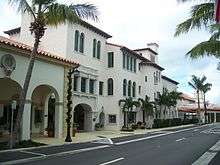
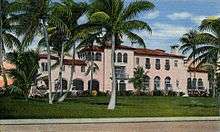
- Mizner designed the Hitchcock Estate in Millbrook, New York, in 1912.[8]
- Mizner's first major Florida commission was the Everglades Club, a Spanish-mission-style convalescent retreat built in 1918, that became (and remains) a private club. It stands at 4 Via Parigi (off Worth Avenue) in Palm Beach.
- Mizner designed the 37-room El Mirasol ("the sunflower"), completed in 1919, for investment banker Edward T. Stotesbury,[9] head of the town’s most notable family of the time. It included a 40-car garage, a tea house, an auditorium and a private zoo. The mansion stood at 348 N. Ocean Boulevard in Palm Beach, but was demolished in the 1950s.
- La Bellucia at 1200 South Ocean Boulevard was built in 1920 for Dr. Willey Lyon Kingsley.[10] In 2009 it was Palm Beach's largest recorded sale at $24 million.[11]
- Another fanciful Palm Beach mansion, Villa Flora, was built in 1923 for Edward Shearson. It stands at 110 Dunbar Road.[12]
- La Guerida ("bounty of war") was built in Palm Beach in 1923 for Rodman Wanamaker of Philadelphia, heir to the Wanamaker's department store fortune. It was later purchased by Joseph Kennedy in 1933 during the depths of the Great Depression for a paltry $120,000, and eventually would become President John F. Kennedy's "Winter White House". It stands at 1095 N. Ocean Boulevard.
- Mizner's own Palm Beach home was built in 1925. It was called El Solano after the hot, oppressive wind which blows off the Mediterranean Sea in eastern Spain, but also for Solano County, California, his birthplace. Sold to Harold Vanderbilt, the estate was later purchased by John Lennon. It stands at 720 S. Ocean Boulevard.
- He designed and built the Riverside Baptist Church in Jacksonville, completed in 1926. Because he promised to build it in honor of his mother, Ella Watson Mizner, the architect refused payment for his services. The church stands at 2650 Park Street, and is Mizner's only work of religious architecture.
- The clubhouse for the Wee Burn Country Club in Darien, Connecticut was designed by Mizner in his Mediterranean style in 1926.[13]
- In 1928, he designed the original Cloister Hotel at Sea Island, Georgia. It was demolished in 2003.
- William Gray Warden Residence (Warden House). 112 Seminole Ave, Palm Beach. 1922. On the U.S. National Register of Historic Places.[14]
- La Ronda in Bryn Mawr, Pennsylvania, Mizner also built a Mediterranean Revival mansion and a seashore house north of the Mason–Dixon line; La Ronda was built in 1929. La Ronda was demolished on October 1, 2009. Some elements were saved for architectural salvage.
- As early as 1925, Mizner, commissioned by Dr and Mrs (Lillian) Thomas Dempsey, to build a beautiful, while diminutive, Mediterranean Revival (it is, possibly, the smallest structure Mizner ever built) as summer home. The house has 22' ceilings, enabling the architect to install a "mezzanine-loggia," circumlocuted by the hand-wrought iron railings for which a classic Mizner building is known. The house, at 100 S, Osborne Avenue, Margate, NJ 08402 (formerly 8704 Atlantic Ave) is on a beach block corner where Atlantic Ave intersects Osborne (a stone's throw away another architectural landmark, known as Lucy, the Elephant, holds court at the corner of Atlantic and Washington Aves.) Jeff Rosen, of Spielberg Productions, who purchased the home from the Dempsey estate, later sold it to Marsha & Michael Birnbaum of Bryn Mawr, PA. It has since been purchased, and is occupied by auteur-singer-poet, Silkë Berlinn (see WIKI)
Boca Raton development
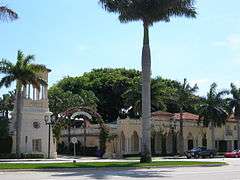
In 1925 Addison Mizner embarked on his most ambitious project, the creation of a fabulous resort at Boca Raton. Unfortunately, this was at the end of the Florida land boom and it ended in bankruptcy in little more than a year. He began by forming the Mizner Development Corporation, a syndicate of prominent investors including Rodman Wanamaker, Paris Singer, Irving Berlin, William Kissam Vanderbilt II, Elizabeth Arden, Jesse Livermore, Clarence H. Geist, and T. Coleman du Pont as chairman. In March the corporation quietly bought up two miles (3 km) of ocean front property with an overall total of over sixteen hundred acres. On April 15, 1925, the syndicate announced this large development, labeled the "Venice of the Atlantic", which would feature a thousand-room hotel, two golf courses, a polo field, parks, and miles of paved and landscaped streets which included a 160-foot-wide (49 m) grand boulevard called Camino Real.[15] In an address before 100 salespeople, the architect declared:
"It is my plan to create a city that is direct and simple... To leave out all that is ugly, to eliminate the unnecessary, and to give Florida and the nation a resort city as perfect as study and ideals can make it."
On the first day of selling lots, May 14, 1925, $2 million was taken in with a further $2 million within the first month. Seeing that the large hotel would take a long time to build, Mizner immediately began work on a 100-room smaller hotel, the Ritz-Carlton Cloister Inn (now called the Boca Raton Resort & Club).[16] Unfortunately for the development, problems with a railroad freight embargo and bad publicity began to appear over the summer. Investors began pulling out beginning with Du Pont in October. By the end of October over $25 million in lots had been sold. Although it was obvious to many that the boom had ended, Mizner doggedly carried on. The Ritz-Carlton Cloister Inn opened on February 6, 1926. Over the winter season an additional $6 million trickled in but sales came to a halt in the spring. Even worse, customers stopped making payments on their contracts and the cash flow ended. This led to Mizner's losing control of the corporation in July 1926 and to bankruptcy in September. The bankruptcy was resolved a year later in November 1927. As well as the Cloister Inn, the corporation had built two large Administration Buildings, a radio station, and twenty-nine homes.[17]
Last years
In 1927 Mizner built a house for John R. Bradley called Casa Serena in Colorado Springs. Several of Mizner's friends got together in 1928 to publish a folio monograph of his work. It was entitled Florida Architecture of Addison Mizner and featured 185 photographs of homes. Paris Singer contributed an introduction and Ida M. Tarbell wrote the text.[18] After 1928 Mizner received several commissions but they came to a stop with the beginning of the world depression.
The one exception was the extensive Dieterich estate, 'Casa Bienvenida' (House of Welcome), on Park Lane in Montecito near Santa Barbara, California.[19] He designed and directed its creation from 1929 to 1930.[20] The significant new Mediterranean Revival estate's budget was unhindered by the 1929 Crash. The naturalistic landscape and formal gardens were designed by atmospheric painter and landscape designer Lockwood de Forest, Jr. (1850–1932). His water channels are replicas of those at Villa Lante at Bagnaia, near Viterbo in the Italian Tuscany region.[21] Mizner integrated the principal indoor and outdoor rooms by a cloistered arcade with slender columns on three sides of a large courtyard. He linked that to the inclined axis with a pavilion in the form of a Palladian arch on a terraced stone pedestal at the vista terminus.[22] Casa Bienvenida is extant and well maintained to the present day.
"The Spanish revival style here draws its forms and elements from medieval sources. Mizner used many high art details not generally found in this area....while maintaining the Santa Barbara characteristic of pure design."[23]
In 1932 Mizner published The Many Mizners, an autobiography covering his youth, years in Alaska, and time in New York until the death of his mother. A second volume telling of his work in Florida was begun but never completed. Mizner died in 1933 of a heart attack in Palm Beach.[24]
Legacy
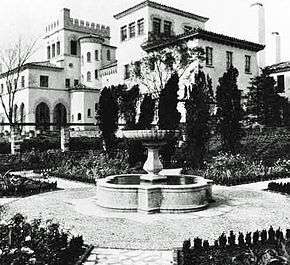
Mizner's buildings were typically dismissed by Modernist critics for their eclectic historicist aesthetic. Many were torn down and redeveloped, but a number of those that survive are now on the National Register.
The Mizner name lives on. On the grounds of the Boca Raton Resort and Club is Mizner Lake Estates, an intimate 15-estate gated enclave of million dollar homes with 24-hour security. In Delray Beach can be found Addison Reserve Country Club, a golf and tennis community of 717 luxury single-family homes situated on 653 acres (2.64 km2). It consists of nineteen villages with names such as "Mirasol" and "Playa Rienta"[25] Also in Boca Raton is Mizner Park an upscale lifestyle center with shops, rental apartments, and offices. In March 2005, an 11-foot-tall (3.4 m) statue of the architect by Colombian sculptor Cristobal Gaviria was erected in Boca Raton at Mizner Boulevard and U.S. 1 to commemorate his visionary contributions to both the city and Florida architecture. In addition, an elementary school in Boca Raton was named for him in 1968.
He was the brother and sometime partner of businessman, raconteur and playwright Wilson Mizner. The brothers' series of scams and picaresque misadventures were the inspiration for Stephen Sondheim's musical Road Show (2008). Previously, in 1952, Addison's friend, Irving Berlin, wrote a musical called Palm Beach which never got produced. It featured Addison, his friends, and his clients.[26] In 1951 Theodore Pratt wrote a novel, The Big Bubble, which is a thinly veiled biography of Mizner.[27]
Gallery
-

White Pine Camp, gatehouse, Paul Smiths, New York (1907). Designed with William Massarene.
-

Everglades Club, Palm Beach, Florida (1918).
-
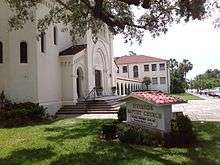
Riverside Baptist Church, Jacksonville, Florida (1926).
-
Memorial Fountain, Memorial Fountain Park, Palm Beach, Florida (1929).
-
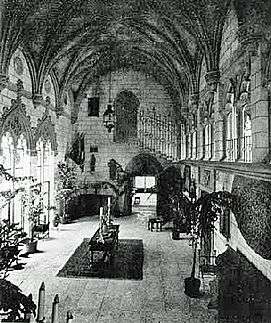
La Ronda, Great Hall.
References
- Notes
- ↑ Herald Tribune retrieved July 11, 2008
- ↑ Orr 1977. p. 5.
- ↑ Mizner 1932. p. 75
- ↑ Seebohm 2001. p. 59.
- ↑ Mizner 1932. p. 186.
- ↑ The New York Times. January 10, 1903
- ↑ "Invasive and Exotic Architectural Species: The Legacy of Addison Mizner". http://www.critiquethis.us. Retrieved 11 November 2013. External link in
|website=(help) - ↑ Michael Redmon (September 14, 2011). "Park Lane". Santa Barbara Independent. Retrieved July 4, 2016.
- ↑ Curl 1984. p. 236
- ↑ Curl 1984, p. 236
- ↑ Miami Herald; December 8, 2009. p. 3C
- ↑ Curl 1984. p. 237
- ↑ Diedrich 2008. p. 102.
- ↑ Palm Beach County listings at Florida's Office of Cultural and Historical Programs
- ↑ Curl 1990. p. 44.
- ↑ Curl 1990. p. 48.
- ↑ Curl 1990. p. 58.
- ↑ Seebohm 2001. p. 238.
- ↑ Seebohm 2001. p. 241
- ↑ USC archives Archived August 2, 2010, at the Wayback Machine.
- ↑ Vogt 1993. p. 106
- ↑ Andree 1980. p.156
- ↑ Andree 1980. p.156
- ↑ Seebohm 2001. p. 254.
- ↑ "Addison Reserve Country Club". Retrieved 12 November 2013.
- ↑ Berlin 2005. p. 455
- ↑ Lynfield 1984
- Bibliography
| Wikiquote has quotations related to: Addison Mizner |
- Andree, Herb and McCall, Wayne, "Santa Barbara Architecture, From Spanish Colonial to Modern"; Santa Barbara, California: Capra Press, 1980
- Berlin, Irving and Robert Kimball and Linda Berlin Emmet. The Complete Lyrics of Irving Berlin. New York: Alfred A. Knopf, 2001.
- Curl, Donald W. Mizner's Florida. Cambridge, MA: MIT Press, 1984.
- Curl, Donald W. and John P. Johnson. Boca Raton; A Pictorial History. Virginia Beach, VA: The Donning Company, 1990.
- Diedrich, Richard. The 19th Hole: Architecture of the Golf Clubhouse. Victoria, Australia: Images Publishing, 2008.
- Lynfield, Geoffry. "Theodore Pratt (1901–1969) a Reassessment". The Spanish River Papers XII (3), 1984. URL retrieved January 21, 2014
- Mizner, Addison. The Many Mizners. Chicago: Sears, 1932.
- Mizner, Addison with Ethel Mumford and Oliver Herford. The Cynic's Calendar of Revised Wisdom of 1903. San Francisco: P. Elder and M. Shepard, 1902.
- Mumford, Ethel Watts, Illustrated and Decorated by Ethel Watts Mumford and Addison Mizner. The Limerick Up to Date Book. San Francisco: Paul Elder, 1903
- Nolan, David. Fifty Feet in Paradise: The Booming of Florida. Harcourt Brace Jovanovich 1984
- Pratt, Theodore, The Story of Boca Raton; Great Outdoors, 1963
- Olendorf, William, Addison Mizner: A Sketchbook Raisonne of His Work; Farmington Hills, Michigan: Gale Group, 1985
- Orr, Christina, Addison Mizner; Architect of Dreams and Realities (1872–1933); Palm Beach: Norton Gallery and School of Art, 1977.
- Seebohm, Caroline, Boca Rococo: How Addison Mizner Invented Florida's Gold Coast; New York: Clarkson Potter, 2001
- Addison Mizner and Resort Architecture
- Vogt, Elizabeth E., “Montecito, California’s Garden Paradise”; Santa Barbara, California: MIP Publishing, 1993
External links
- Works by Addison Mizner at Project Gutenberg
- Works by or about Addison Mizner at Internet Archive
- A Boca Raton home by Addison Mizner
- El Mirasol and the Stotesburys
- Boca Raton Historical Society
- Historical Society of Palm Beach County, Florida
- RockHall an Addison Mizner designed Colebrook, Connecticut B&B
- "The Cynic's Calendar 1904". Retrieved 2 October 2009.
- "Trouvais Blog, La Ronda recycle". Retrieved 11 March 2010.
- "The Impulsive Traveler". Washington Post, Julia M. Klein. April 6, 2011. Retrieved 16 October 2013.
